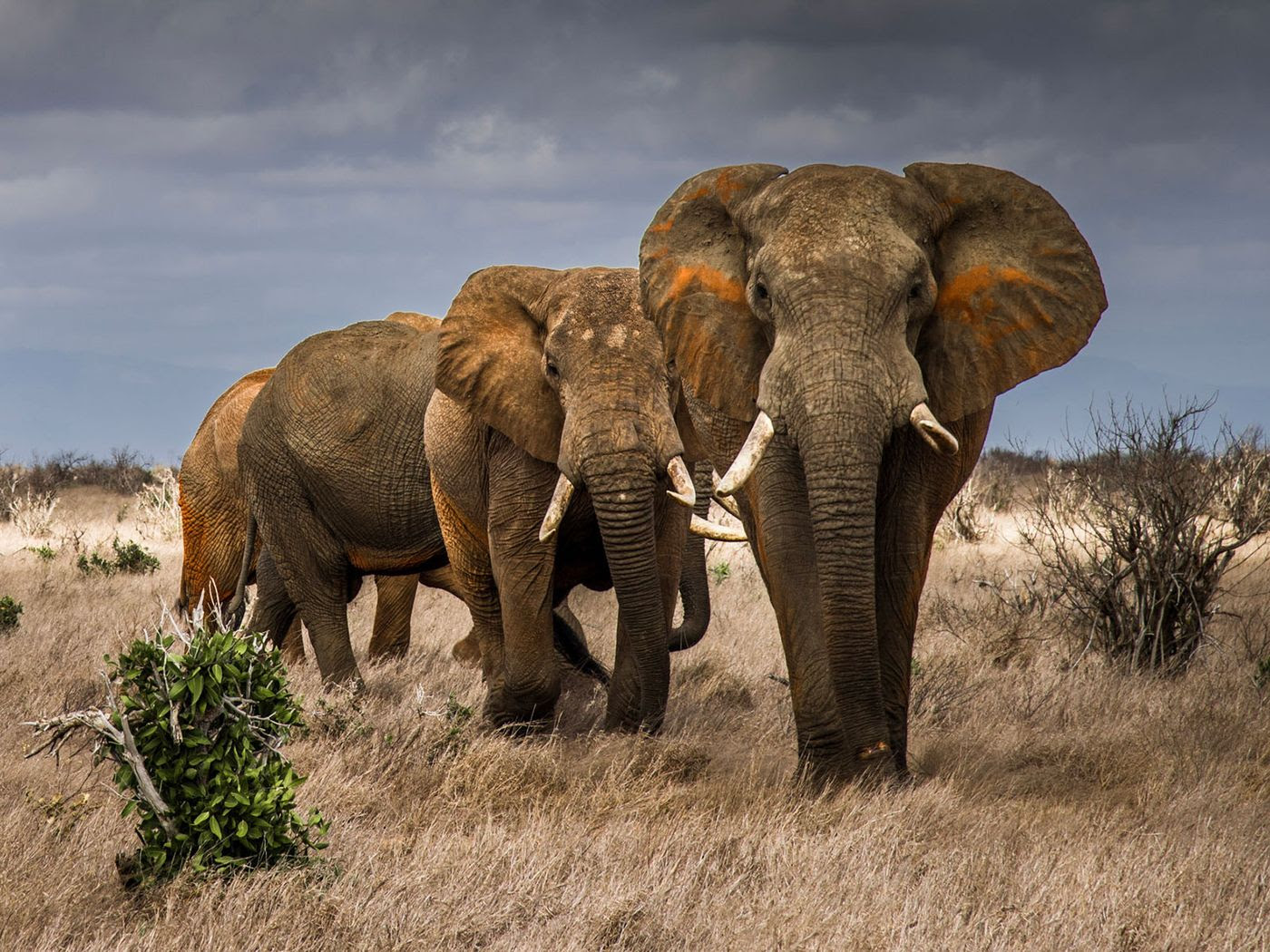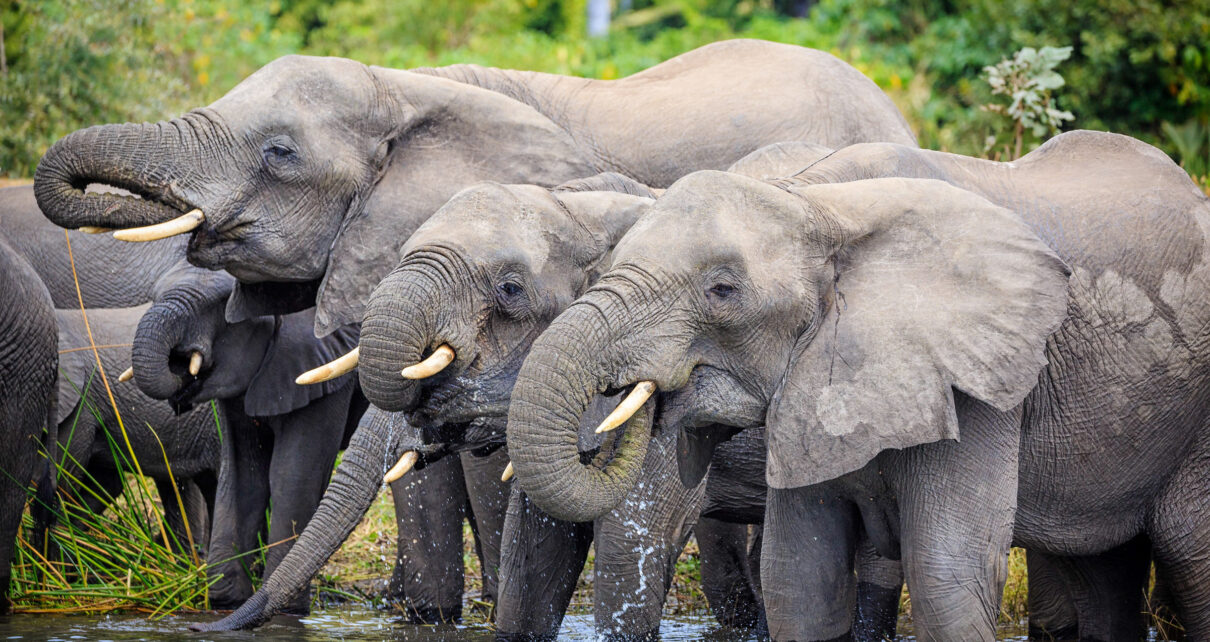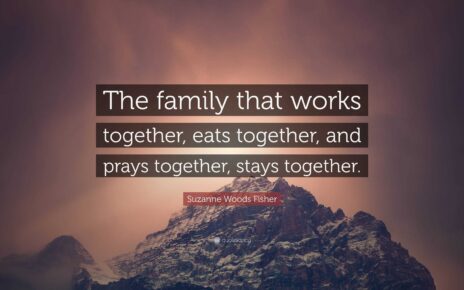/https://tf-cmsv2-smithsonianmag-media.s3.amazonaws.com/filer_public/00/e7/00e77e67-dc6b-420c-b7bd-2ad63bae743b/2015-tsavo-frank-af-petersens_save-the-elephant_web.jpg)
Savannah elephants walk through tall grass in Tsavo, a region in south-eastern Kenya. Trouble often begins when elephants stray from a protected area into human-dominated landscapes. © Frank af Petersens / Save the Elephants
The armed men aren’t supposed to be here. We are several miles inside Buffalo Springs National Reserve in northern Kenya, and the driver I hired for this reporting project and I are checking out a rumor that the reserve’s elephants may have gone missing. Nearly 8,000 elephants have inhabited the broader Samburu-Laikipia ecosystem, which covers around 21,200 square miles. They should be easy to find, but the area is in the grip of drought, which has exacerbated simmering conflict among armed local communities fighting over livestock, grazing lands and limited water supplies. Some of these armed groups have moved into protected areas like Buffalo Springs, driving the elephants away, sometimes by shooting at them and sometimes because elephants often flee areas of high human activity. Instead of pachyderms, we find grazing cattle and herders with guns. They stop to watch us as we pass.
Back at the park gate, an itinerant trader warns us to be careful. “Not a week passes without something happening here,” says Daniel Lochilia. “People are being killed. Good luck in finding any elephants.”
With so many armed men and their cattle in the reserve, the elephants have likely fled to face an uncertain future in the human-dominated landscapes that lie beyond. The issue is indicative of the battle to save Kenya’s—and, more broadly, Africa’s—elephants, which has entered a new phase. A pachyderm decline that was once mostly fueled by poaching is now being driven by conflict between humans and elephants.
Elephants are notoriously difficult to count across such a wide area. But according to a report by the World Wide Fund for Nature, as many as ten million elephants lived in Africa in 1930. Fifty years later, the figure is thought to have fallen to around 1.3 million elephants, although no one can be sure of the exact number. Now around 500,000 live on the continent, according to an expert with the nonprofit Save the Elephants, and savanna elephants such as those found in Kenya’s north are classified by the International Union for Conservation of Nature as endangered. Smaller forest elephants, which the organization assessed as a separate species for the first time in 2021, are listed as critically endangered. From the mid 1980s, when poachers were killing an estimated 100,000 elephants for their ivory every year, until recent years, ivory poaching was the greatest threat to the species. With so many elephants being lost, scientists feared they could go extinct.
/https://tf-cmsv2-smithsonianmag-media.s3.amazonaws.com/filer_public/4c/a8/4ca8d161-b8b0-4fff-a44c-f1a109d38aff/gigantic-female-tusker-14th-feb-2013-tsavo-east-lucy-king_save-the-elephants_web.jpg)
A female elephant leads her two youngsters to a known waterhole in Tsavo East National Park, Kenya. Keeping corridors open
In 2013, the Elephant Crisis Fund (ECF) was launched to help combat the decline in elephants by reducing demand for ivory, stopping ivory poaching and fighting the trade in ivory. “It has been an immense success, because the Chinese government banned the domestic trade in ivory and was effective in maintaining that,” ECF director Chris Thouless says.
With demand suppressed, ivory trafficking has slowed to a trickle, and poaching has declined significantly. Thouless calls the results “a fragile success,” because poaching could return if anti-poaching programs are relaxed and demand for ivory spikes again in Asia.
But for now, human-elephant conflict is the main threat to the majestic creatures. When drought and ethnic conflicts drive people into protected areas, the displaced elephants do battle over water and food in the villages and farmlands that surround the reserves. In such confrontations, frightened elephants sometimes trample and kill people, and elephants are often shot and killed in retaliation for the deaths and other damage they cause. But conservationists are trying creative methods, using everything from bees to craft beer, to reduce the conflicts.
Population figures are being updated all the time, but later this year, experts will have a more exact measure of how savanna elephants are doing when results from a major southern African census conducted by governments, park authorities, conservation groups and scientists are released. But based on the preliminary findings, experts are cautiously optimistic about overall elephant numbers.
“Across the board, we’re seeing a small number of localized declines, but we’re not seeing major declines of large populations,” says Thouless. “I also don’t know of any populations which are in decline as a result of poaching for ivory. It’s a complete contrast to the situation ten years ago.”
In some elephant strongholds, the species is doing exceptionally well. An estimated 225,000 savanna elephants inhabit the Kavango Zambezi Transfrontier Conservation Area—a patchwork of protected areas that spans parts of Angola, Botswana, Namibia, Zambia and Zimbabwe. This represents around half of all savanna elephants in Africa.
But not all elephant populations are prospering. Outside of those strongholds where elephant numbers are increasing or stable, “we’re seeing a gradual loss of elephants from whole countries as habitat loss and increased conflict take hold,” says Thouless.
In Kenya, which is home to an estimated 35,000 to 37,000 savanna elephants, porous borders have allowed guns and ammunition to move into the country from Somalia, Ethiopia and South Sudan. The weapons have fueled the ethnic conflicts that push people into protected areas. “Before, in the historical raids between communities, they used spears and pangas,” says David Daballen, director of field operations for Save the Elephants. “Now they use AK-47s.”
The ready availability of guns has also made it easier for people to kill elephants, either because the elephants are rivals for scarce resources or because they threaten villagers’ safety.
Elephants can do a lot of damage. “During this latest drought, we even saw elephants going into the villages for the first time, raiding food in houses and knocking the houses over when people were actually inside at the time,” says Daballen.
And as the human population grows across Africa, developments block elephant corridors and occupy areas that were once the domain of wildlife. Just in Kenya’s northern Isiolo County, which includes Buffalo Springs, the human population has nearly tripled in just over two decades, from 100,000 in 1999 to almost 300,000 in 2023.
To help reduce conflict, conservationists and local communities are implementing several measures. Lucy King, the head of the human-elephant coexistence program with Save the Elephants, has compiled the “Human-Elephant Coexistence Toolbox.” It brings together more than 80 different solutions, such as promoting elephant-proof ways for storing food and building walls around water sources.
/https://tf-cmsv2-smithsonianmag-media.s3.amazonaws.com/filer_public/3a/36/3a368d27-69b1-41e4-af93-f3622548f4b3/bamako-water-tank-protection-lucy-king_save-the-elephants_web.jpg) Strategically placed angular rocks will prevent elephants from accessing a water tank. Solutions such as these are found in Save the Elephants‘ Human-Elephant Coexistence Toolbox. © Lucy King / Save the Elephant
Strategically placed angular rocks will prevent elephants from accessing a water tank. Solutions such as these are found in Save the Elephants‘ Human-Elephant Coexistence Toolbox. © Lucy King / Save the Elephant
One of the most popular conflict mitigation strategies involves bees. Their efficacy in keeping elephants at bay was identified almost by accident when a northern Kenyan farmer told conservationists that one of his trees wasn’t being damaged by elephants because it had a beehive in it.
“This is not a story of Westerners coming to Kenya and discovering this,” says King. “This came from traditional Africans working in the bush.”
To keep elephants out, conservationists funded local farmers to build beehive fences. This involves mounting wooden or plastic beehive boxes 4 or 5 feet off the ground every 65 feet or so with wires between them. Dummy hives in between the active hives prevent colonies from fighting with each other because, King says, African bees are much more aggressive when it comes to defending their hives than European or North American bees. It takes 12 beehives and 12 dummy hives to enclose an acre. If an elephant tries to push through the fence and disturb the hive, the bees attack. Any sting to the softer skin around the elephant’s eye, mouth or even the inside of the trunk can cause pain and swelling, prompting elephants to panic.
/https://tf-cmsv2-smithsonianmag-media.s3.amazonaws.com/filer_public/9c/26/9c263eaa-03d9-4918-96b7-5d7cc300cc84/bee-web.jpg) Bees swarm a hive that hangs from two wooden fence posts. Part of a beehive fence that encircles farms, active hives such as these deter elephants from entering and destroying the crops. © Naiya Raja / Save the Elephants
Bees swarm a hive that hangs from two wooden fence posts. Part of a beehive fence that encircles farms, active hives such as these deter elephants from entering and destroying the crops. © Naiya Raja / Save the Elephants
With this tactic, farmers not only better protect their crops but can also sell the honey, which provides an alternative source of income. Since the program’s inception, Save the Elephants has funded more than 650 beehives in southwestern Kenya alone, and communities in 23 African countries have adopted the program. Helping farmers protect their crops and develop alternative income streams with bees has also earned conservationists the trust of otherwise resistant farmers. This in turn makes possible conversations about other issues, including protecting elephant corridors.
/https://tf-cmsv2-smithsonianmag-media.s3.amazonaws.com/filer_public/67/59/67591f06-9623-4454-9d7d-b41430c195f1/ste-team-monitoring-a-beehive-fence-in-sagalla-with-sunflowers-jasper-scofield_save-the-elephants_web.jpg)
A team monitors a beehive fence that surrounds a field of sunflowers. Beehive fences require regular maintenance, but the pollination services and income from honey make them an attractive option for subsistence farmers. © Jasper Scofield / Save the ElephantsBut for all its successes, the beehive prevention method has limits. One area where the beehive solution hasn’t worked is northern Botswana, in an area of the Okavango Panhandle that is home to 20,000 humans and 18,000 elephants. There, the elephant population has doubled in the past 15 years. Unlike in Kenya, the local farmers have no tradition of beekeeping. And the dry winter climate makes it difficult for the bees to survive.
While the beehive solution is being retested, local nonprofit Ecoexist uses tools like chili fences and solar-electric lights to deter the pachyderms. “Elephant Express” school buses now ferry schoolchildren safely across the corridors they would otherwise have to cross on foot, dodging the giant creatures as they went. Ecoexist has also mapped the corridors, and local authorities now use these maps to reject planning permission for new buildings that would block the elephant pathways.
At the heart of Ecoexist’s approach is trying to help local farmers profit from living alongside elephants. To do this, the nonprofit helps formerly subsistence farmers increase their crop yields, thereby reducing the need to expand farms into the elephant’s world. They also buy the farmers’ surplus millet at double the market price, provided the farmers have protected their fields from elephants, practiced sustainable agriculture by rotating their crops and refused to expand their footprint into elephant corridors.
Because they only receive the favorable market rate if they keep their end of the bargain, says Ecoexist policy director Graham McCulloch, “it reinforces for farmers that there is this opportunity and this benefit, but only because they’re coexisting with elephants.”
Ecoexist expanded their approach beyond that of a traditional charity. A few years ago, it created a separate legal entity: the first licensed microbrewery in the city of Maun, Botswana—the Okavango Craft Brewery—where it uses the millet it purchases. “We wanted to create a market-linked incentive, not a subsidy,” says McCulloch.
Next up, the organization plans to reward local communities for their elephant-friendly practices by selling carbon credits on the global market. Also known as payments for ecosystem services, such credits enable international companies to buy into sustainable projects such as Ecoexist and the communities they work with as a way for the companies to offset their own carbon emissions. Such a move would ensure that the entire community, and not just those within the community who farm, benefits from living alongside elephants.
But McCulloch notes that living with elephants is difficult, and mitigating conflict is really hard work. “The more we chip away, the more we can build the tolerance level,” he says. “That’s what coexistence is all about.”







